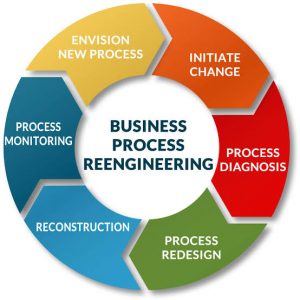BPR – A business tool for survival and growth in challenging times

Article By
Jiz P Kottukappally
Chief Executive Officer
Yescalator Management and Financial Consultants
Time and again Charles Darwin’s theory of evolution that it is not the strongest of the species but those species that are more adaptable to change only will survive is proving itself as not only a theory on the evolution of species but even as a vital management principle on the survival of organisations. The inventions in the field of mechanical engineering have proved it long back. The use of computer applications and information technology in business has reiterated it in the early 1990s. Specifically, in the Indian context, the liberalisation, privatisation and globalisation measures initiated in 1990s have proved the need for companies to adopt to change if they have to survive. Though Darwin’s theory of evolution has been proved correct in the business environment also still Newton’s first law of motion that there is an inertia to change and an object in a state of motion or rest will continue in the same state until an external force is applied is also equally applicable for many of the organisations. Undoubtedly, there is a resistance to change in most of the organisations and unless there is an external pressure revisiting the existing and rebuilding the needed does not normally take place.
Though Covid-19 has its negative impacts on the health, wealth and well-being of individuals and organisations it has created an external pressure on many organisations to relook at how they have been operating and bring in operational efficiency and cost reduction. Here there could be two response approaches that an organisation can undertake iterative response approach and radical response approach. The iterative response approach is mostly responsive to the changes in the environment. It focuses mostly on those opportunities that improve processes, but will not fundamentally change them. Here the focus would mostly be on reducing waste, errors, cycle time, etc. Radical response approach will look at enabling the organization to do existing things in a new way or even look at doing new things. As many experts are taking of a new normal post Covid-19 it would be better for organisations depending on the segment they are operating to look at radical response approach rather than iterative response approach. For eg many of the big IT and ITES companies have declared work from home as a policy for quite long period of time. If that is the case would it not make sense for even smaller companies in the IT sector to look at radical response approach rather than an iterative response approach and lay down completely new process for assigning, reporting, reviewing approving and submitting the various projects undertaken by them? Similarly, with more and more people getting used to hassle free online purchase would it not make sense for small and medium retailers to take a radical response approach and revisit their brick and mortar outlet strategies? With classes being online with work from home being the new rule and online shopping replacing the shopping experience of people will the relevance of urban and metro cities come down? If that is the case should not the real estate builders and developers look at a radical response approach in their areas. If lot of educational activities can happen online should not educational institutions have a radical responses to the current Covid-19 situation?

For businesses looking at radical response approach to the current covid situation it would be good to look at conducting a Business Process Reengineering (BPR) exercise for the organisation. BPR started getting attention in big way since early 1990s with technology being used as a key enabler for supporting business. While many firms looked at automating all the works that were done the firms which focused on reengineering paid more attention for eliminating forms/works that do not add value, rather than using technology for automating it. Great management thinkers like Peter Drucker and Tom Peters were accepting and advocating BPR as a new tool for growing successfully in a dynamic world.
Business process reengineering (BPR) is the practice of rethinking and redesigning the way work is done in an organisation. The focus of BPR is to better support an organization’s mission and reduce costs. The first focus of any reengineering activity that is taken up by a firm should be to be more customer centric and ask the following important questions.
1. Who are our customers?
2. What do they want?
3. What has changed for them?
4. How do we serve them better?
Answers to these questions will help the organisation to find out what is to be done and then go ahead and decide how best to do it. If this fundamental question is not asked more focus will be on modifying the existing processes, many of which would not be relevant at all from a customer point of view in the post Covid-19 new normal post. Business process re-engineering identifies, analyzes, and re-designs an organization’s core business processes with the aim of achieving improvements in critical performance measures, such as cost, quality, customer service, and speed. A well done BPR will bring about changes in strategy, people, organisation and technology. In short, BPR aims at bringing in fundamental changes required for organisational growth.
Once the customer centric aspect has been taken care and what are the requirements of the customer has been understood then the focus should be on analysing the design of workflows and business processes within an organization. The analysis should help in identifying irrelevant process in the new normal, improving operational efficiency, reduce time of operations, reduce cost of operations and most importantly improve customer service. Only if customer centric focus is laid full scale revisiting of entire process and recreation will happen. Otherwise only iterative optimization of sub-processes will happen.
Once the broad framework has been set the next step would be to see how the resources are used to create products and services that meet the needs of particular customers or markets. Any business process can be broken down into specific activities, measured and improved. It can also be completely redesigned or eliminated altogether. Business processes can be broken down into sub-processes and tasks that are carried out by several specialized functional areas within the organization. If the process itself is irrelevant there is no point in optimising the performance of the sub process. BPR thus looks at the relevance of the process first and if this process is relevant then looks at optimising the sub process.
The most important step required for successful implementation of BPR is the top management sponsorship and buying from all the employees involved. The need for change should be clearly felt by the top management as well as all the employees. The pain points should be identified and processes needs to be investigated in detail. During the detailed investigation there would be process which add value from a customer point of view, process which add value from an organisation point of view. There could even be non-value add process say for eg maintaining inventory. Inventory is considered as non-value add as it is not being transformed while sitting idle. In addition to this, it consumes space and capital. No doubt some amount of inventory is required for smooth functioning of the organisation and meeting the timelines. But excess inventory build-up is will result in additional storage and capital. This could be due to lack of standardized procedures or inconsistent application of procedures, unbalanced workflows, large batch sizes etc. Detailed investigations and root cause analysis done as part of the BPR exercise will reveal the reasons.
After detailed investigations unwanted process should be eliminated and other process should be redesigned to suit the new requirements. Once the new process has been discussed, designed, tested and finalised it can be implemented. There should be strong management will for getting the new process implemented. If the strong will is lacking by the management then sooner or later implementation will fail and all efforts will be wasted. Proper monitoring and evaluation at periodic intervals should be there for ensuring successful implementation. Ongoing continuous improvements will also be required till things reach a steady state and top management must maintain this flexibility.
Apart from the customer satisfaction and cost reduction the various other changes that a BPR exercise could bring in an organisation would be a shift, from functional departments to process teams, from fixed compensation for skill and time spend to compensation for performance and results, from division of labour to multitasking, from hierarchical organisational structure to flat organisational structures, from separation of duties to cross functional teams, from single line of control to parallel reporting, from linear and sequential process to parallel process, from sequential reviews to real time parallel reviews and even from mass production to mass customisation.
Convincing every affected group within the organization of the need for BPR is a key step in successfully implementing a process. That is why it is all the more relevant and sensible to start from a customer point of view and look at what the customer wants. The customer is the reason for a commercial organisation to exist. In some bigger organisations even customers are included as a part of the BPR team to give real time feedbacks on the process. Naturally there would be resistance to change. By informing all affected groups at every stage, and emphasizing the positive end results of the re engineering process, it is possible to minimize resistance to change. While managing the change, organisations should understand and appreciate that employees are human beings and thus the rational of change and the need for the change should be frequently communicated and they should be taken to confidence. Unless employees realise the need for change, organisations won’t change. The ultimate success of BPR depends on the strong, consistent, and continuous involvement of all employees within the organization. The Covid-19 situation – the lockdown and the developments thereafter – has hopefully created an awareness about the need for change which the organisations can now capitalise and initiate their reengineering process.
Pic Courtesy: google/ images are subject to copyright












